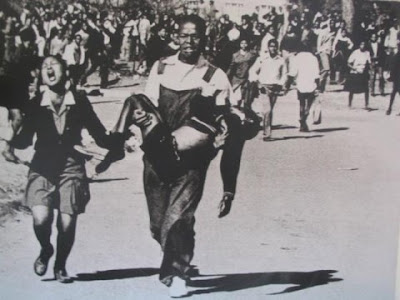South Africa: Role of the Iconic Image, Cont'd
Africa is a Country reviews some documentaries about the youth uprising in Soweto, June 16, 1976. CNN's Isha Sesay talks about the iconic photograph that's become emblematic of the day:
More thoughts on iconic photographs, the state and uprisings - here.
Iran: You've Come A Long Way Baby

(Photo: A supporter of defeated Iranian presidential candidate Mir Hossein Mousavi shouts slogans during riots in Tehran on June 13, 2009. By Olivier Laban-Mattei/AFP/Getty.)
In the 1.11 PM post, Sullivan is struck by the number of Iranian women in the trenches of this revolution. NY Times' Roger Cohen, who is on the ground, concurs:
I also know that Iran’s women stand in the vanguard. For days now, I’ve seen them urging less courageous men on. I’ve seen them get beaten and return to the fray. “Why are you sitting there?” one shouted at a couple of men perched on the sidewalk on Saturday. “Get up! Get up!”Another green-eyed woman, Mahin, aged 52, staggered into an alley clutching her face and in tears. Then, against the urging of those around her, she limped back into the crowd moving west toward Freedom Square. Cries of “Death to the dictator!” and “We want liberty!” accompanied her.
Already the pictures/video of the woman shot by the Basij has iconic written all over it--think Killing at Kent State or Accidental Napalm --and whatever becomes of this revolution, Ahmedinejad, Khamenei, the Sepah and the Basij's days are numbered. As one of Sullivan's readers puts it, "...way I see it, that truly horrific footage of the conservatively dressed woman bleeding out...

... will do more damage to Ahmadi and Khamenei than any military strike ever could."
The role of iconic images in the way people relate to the idea of the state or any collective identity is well captured in this essay by Robert Harriman and John Lucaites, where they argue:
We want to go a step further to suggest that the public sphere depends on visual rhetorics to maintain not only its deliberative "voices," but also its more fundamental constitution of public identity. Because the public is discursively organized body of strangers constituted solely by acts of being addressed and paying attention, it can only acquire self awareness and historical agency if individual auditors "see themselves" in the collective representations that are the materials of public culture. Visual practices in the public media play an important role at precisely this point. The daily stream of photojournalistic images, while merely supplemental to the task of reporting the news, defines the public through an act of common spectatorship. When the event shown is itself a part of national life, the public seems to see itself in terms of a particular conception of civic identity.Twitter and YouTube afford the protesters, unlike no other time in the history of human communication, the ability to create the necessary "collective representations" that instantaneously add up their individual acts into an identity and is constantly feeding that identity being constituted into the discourse of a growing rhetorical shift we see transpiring right before our eyes. What is, however, trippy about these images is how they serve as legitimating and constitutional materials for not only the Iranian protesters but for the Obama age of foreign relations and for Obama supporters in America -- the interdependency and coexistence of this new and old bloc is fueling the creation, consumption and distribution of these visuals and, hand-in-hand, creating the hunger for the overall rhetorical exertion still in progress.
On this side of the ocean, the West welcomes and have technologically enabled the visual rhetoric coming from Iran, which oddly turns out to be the affirmation of the fight--and continuing liberal struggle--for the new identity American voters rolled the dice on less than a year ago. On the Iranian side of the fence, the images they are creating and which their leaders want suppressed, also feed into that particular conception of Islam, modernity and of the collective identity they desire and are in fact dying for right now on the streets of Tehran.
>VIA: http://bombasticelements.blogspot.com/2009/06/iran-youve-come-long-way-baby.html
